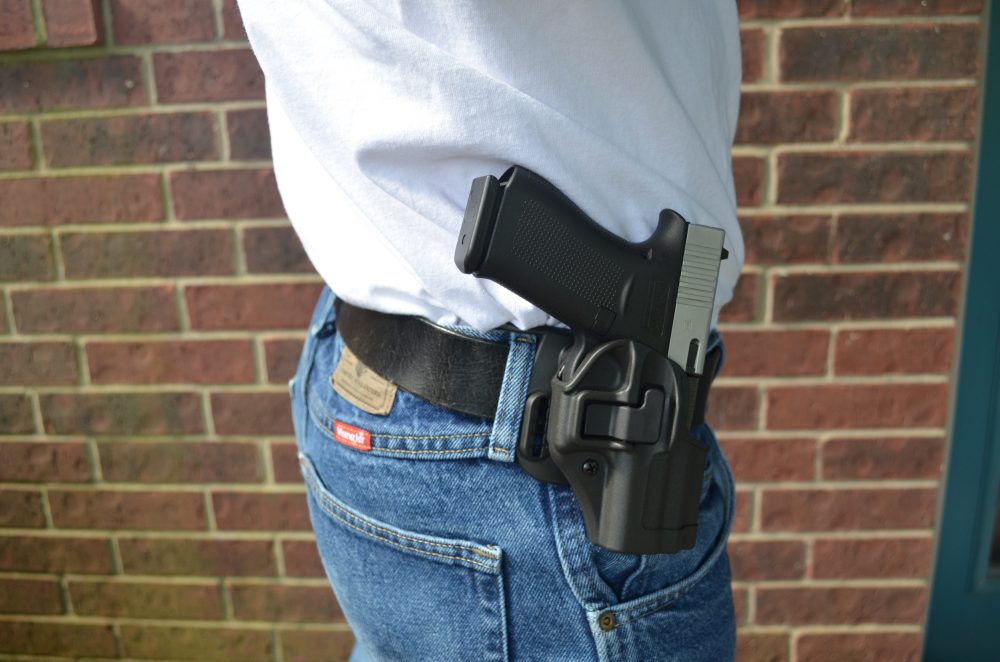For years, so-called smart guns have been touted as a solution to accidental shootings. But the technology has remained largely out of reach – until now.
This year personalized guns may finally come to market in the United States, where there were some 2,000 accidental shooting incidents in 2021, according to the nonprofit Gun Violence Archive. Two companies have working prototypes, and one of them is testing their models with law enforcement agencies.
But critics worry about ease of use and potential regulations.
Reporter Daniel Trotta has been following the development for Reuters. He tells Texas Standard that smart guns can only be used after being unlocked with a fingerprint sensor, radio-frequency identification (RFID) chip, or pin combination.
“The idea is that the gun only fires for you or another authorized user, such that if it’s lost or stolen, it’s inoperable,” Trotta said. “Or, if a child in the house gets it, they can’t accidentally fire it. Or if a teenager wants to take it to school and shoot up the school, it’s not going to work for that person.”
Listen to the full interview with Trotta in the audio player above or read the transcript below to learn more.
This interview has been edited lightly for clarity.
Texas Standard: For those not familiar with this idea, what exactly are smart guns and how do they work?
Daniel Trotta: The idea is that this gun only fires for the owner or the authorized user. There are a number of techniques they can do that, either a fingerprint reader or a some type of near-frequency communication or radio-frequency identification that would communicate between the chip in the gun and either a ring or a bracelet, or even something as simple as a pin pad.
The idea is that the gun only fires for you or another authorized user, such that if it’s lost or stolen, it’s inoperable. Or if a child in the house gets it, they can’t accidentally fire it. Or if a teenager wants to take it to school and shoot up the school, it’s not going to work for that person.
I recall seeing news stories and even advertisements for smart guns in some magazines. This is a concept that has been in the works for years now. I remember one of them had an RFID chip implanted inside a bracelet kind of thing. What’s new? What’s changed?
Well, that project was something of a failure. There was a German company that introduced it to the market. And what happened was the gun was hacked. That is, people could stop the gun from firing or more significantly, fire the gun without authorization, using magnets and other methods. The gun was also very expensive. It was a very low caliber. There was lots of reasons why it didn’t take off, including the fact that there is this New Jersey law that, at that time, would have required that all gun shops in New Jersey only sell that gun.
Since then, a number of small startups have been pursuing this on their own. The technology has advanced a lot in the past seven years, eight years, since that happened. What’s interesting is that the major gunmakers are not, or at least not publicly – there’s some belief within the industry that they have their own plans in research and development. But nobody wants to be first among the big gunmakers for lots of reasons. And so it’s left to the small companies to move this forward.
I guess not the least of which are gun-rights activists who don’t like the idea for a variety of reasons, and some of these long- term traditional gun manufacturers fear a certain backlash, right?
Yeah, that happened once before Smith & Wesson entered an agreement with the Clinton administration to promote gun safety, including to set aside money for research and development into smart guns. At that time, and this is even before the New Jersey law was even on the books, there was big backlash from the National Rifle Association and the rest of the gun lobby. And it really hurt the bottom line for Smith & Wesson, which quickly retreated.
I thought that a lot of gun manufacturers try to at least put out a signal that they want to do everything in their power to keep guns out of the wrong hands, to prevent accidental shootings, to prevent accidental firings. Why would those companies be dragging their feet? Does it all have to do with the the market for existing firearms, or what?
The official line is, We don’t oppose smart guns as long as they don’t come with mandates. And this New Jersey law did play a big part. First, the law said when smart guns come onto the market, gun shops in New Jersey can only sell those. That was repealed and replaced with a new law that says all New Jersey gun shops must offer a smart gun once it’s available and on the market.
There’s also this other fear that the technology isn’t going to work or not going to be reliable, and so much of gun culture is based on this fear that somebody is invading your home and that you’re going to need to use your gun defensively in a crisis moment and that you forget the pin pad or it’s raining and the fingerprint reader doesn’t work, or that there’s some glitch in the technology and the bad guy is going to get to you before you can get to him.
But the New Jersey law did signal at least some indication that governments were going to get involved and potentially regulate this matter. And that is really what turns off people who are defenders in the Second Amendment.
You reported that smart gun companies now say they’re planning on bringing these guns to market this year. Any timeline, and how likely is that looking?
They both say this year. The gun that we witnessed fired on the range in Boise, Idaho, was made by Lodestar. They have a third-generation working prototype. They say they’re ready to ramp up within the second half of this year. Maybe, just maybe the fourth quarter. The other company, Smart Guns, based in Kansas, already has a working prototype that’s in the hands of law enforcement who are testing it out, and they to say second half of this year, perhaps fourth quarter, that they hope to have a commercially available product that they can sell to law enforcement and civilians.
As you mentioned, the reliability question, especially say, if you’re trying home self-defense in a time of stress, that’s been a major factor in some of these previous ideas not picking up any steam. From what you can tell, have the bugs been worked out of this latest generation of smart guns?
So far, as best we can tell, more testing perhaps needs to come into it. A lot of it, though, really comes down to how confident are you in modern technology and the makers of these guns? Certainly in the case of LodeStar, they’re aiming for a younger generation; 40 and under, say, first-time gun buyers – people who have been using their cell phones all their adult lives and and have no problem relying on technology in a moment’s notice.
I think the older, more traditional gun users, especially some who grew up using revolvers – remember, there was resentment against semi-automatic 9 mm when they first came out because of the same thing. So it’s going to take some time. Eventually, the technology should be there, whether these particular guns have an unforeseen problem that we don’t know yet, but certainly it’s not such a great leap technologically to get there.














